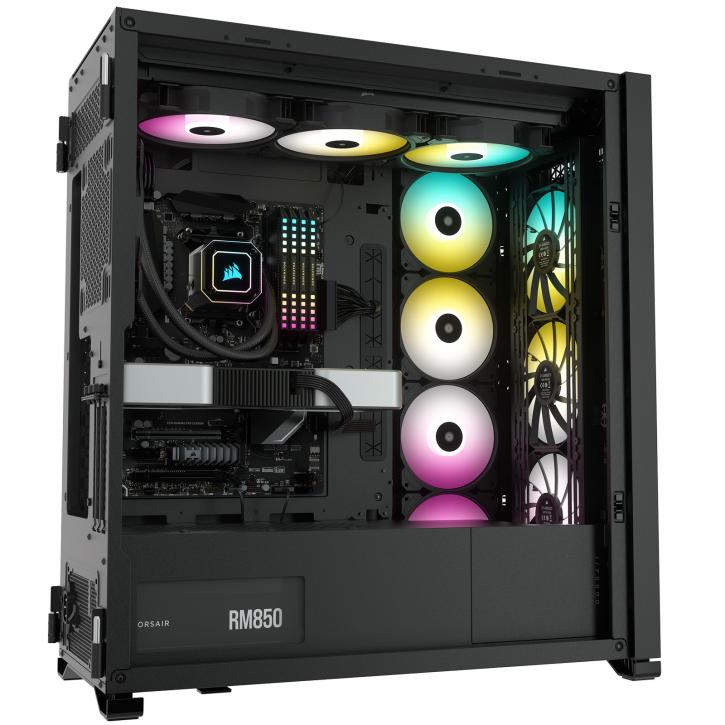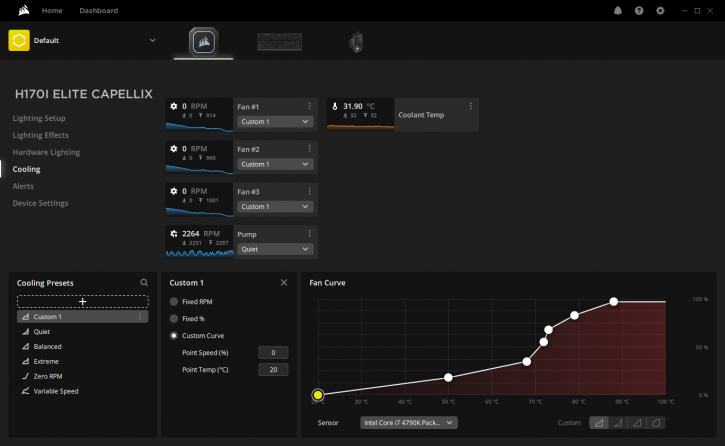Final words and conclusion
Final words and conclusion
Corsair over the years has placed so much innovation into the H range of LCS coolers, and that shows exactly in the product tested to date. The H170i Elite Cappelix looks nice, and be tweaked in RGB and front-facing plate as well it is silent and offers grand cooling performance. The above keywords are all trivial though, as the best feature to me is the removal of wires from the visual area, your motherboard CPU area. There now is one wire leading to the motherboard, and one wire to the Corsair NODE/HUB. From there on it, all gets connected and linked up. The beauty there is that all wires can be hidden far more easily, bringing in an aesthetically more pleasing to look at the product. Clean, that's the word I am looking for, cleaner perhaps. Next to that, this unit can be configured to become really silent, which is a big positive in my book. While the default clocked performance showed slightly better than traditional Corsair series H results, it was the opposite when we started to tweak. The kit really showed it has a lot of capacity available. For the Elite Capellix versions, Corsair focused on cable management, aesthetics including niche RGB, whilst offering more or less similar cooling performance levels as its predecessors. It is an outstanding product that comes with plenty of cooling capacity. With that box ticked away, you need to move onwards towards aesthetics and noise levels. The inclusion of ML140 RGB fans is nice. And I know that people in general, however, do not understand ML fans. They make heaps of noise at full voltage 12v, and thus people frown upon them. However, they are not designed to run at 12v; we're talking low RPM airflow at say 3 volts say 500 RPM, the airflow of these fans is higher than what you normally see. These fans move proper amounts of air at low RPM. And since they can do that at low RPM, the kit offers lower acoustics with more airflow. That, in a nutshell, is what the ML fans are all about. They are also PWM compatible and have 8 addressable LEDs. If you combine that with iCUE that allows you to control all in software, you realize that you just purchased an incredibly flexible solution with really nice looks. Just pop the unit in, set it in balanced mode. This option offers proper performance at acoustic levels you can hardly hear (if you can hear it at all). Magnetic Levitation equals little to no friction, and at low RPM, you gain pretty terrific airflow whilst hardly making noise. That shows in the DBa measurements as this kit easily was one of the most silent ones we have ever tested.
Aesthetics & Design
The overall looks are very nice; that, however, is a subjective statement, of course. You will get that all-black design with subtle shades of grey, which makes it an appealing product to the eyes. There are 33 RGB LEDs inside the pump that can be addressed individually, allowing some awe-inspiring effects. It's the very same with the ML140 RGB fans. The LED system can be as loud or subtle as you want it to be, as hey everything and anything can be configured to your preference. If you do not appreciate the RGB hype, don't activate or just set a subtle single static color, and your problem is solved. Actually, I do so myself, I set a single static subtle white, and that's it. While we're on that topic, the added benefit if you use iCUE is that you not only change the color animation of the Corsair logo embedded into the cooling block, you can match up any RGB color. We can imagine that with an ASUS ROG-themed motherboard, you'd change that to red, perhaps orange or orange with an accompanying Gigabyte Aorus motherboard and perhaps white with an MSI Titanium series motherboard. As subtle as that LED is, it really does bring a 'finished' feel to your final PC build and color theme. Remember, iCUE can sync up all your Corsair components, and the software has made huge steps ever since its initial release. I am not saying it's perfect but has become something really good.
Installation
Much like the other models, the kit was straightforward to install with its mounting system. The unit is factory-filled with coolant in a closed loop. Just install the backplate, the standoff screws, position the cooler and secure it. The black design will make this kit look great on any PC. It simply is a good alternative to heat-pipe coolers with the added benefits of being fairly quiet whilst offering very nice looks. No 'advanced' skills are required other than the need for ten minutes to install the kit.
Pricing
So here's where things take a different turn, the Corsair H170i ELITE CAPELLIX got introduced at a price of roughly 229 USD for the 420mm model tested. We expect roughly similar prices in the EU, but that depends on the VAT in your country and the USD to EURO differential. The price premium really is due to the ML140 RGB fans and the included NODE Controller.
Conclusion
Certainly, the H170i is literally and visually a bit of a bazooka. The results are good, the looks great, and the functionality of cable management is superb. However large, 420mm, you must really check if this puppy is actually inside your PC or not. You should also ask if you need 420mm, as you also get almost the same results for a CPU of 240mm or 3600mm in terms of relative cooling. However -- The advantage of a bigger radiator is that you have more capacity to fool around with, and that means that you have the capability to configure your fan RPM at low values all the time. Now we've been impressed. Not so much about the default cooling performance, but moreover the additional cooling capacity versus acoustics. Once we overclocked the processor, this cute little setup easily dealt with that additional heat. For easy sheer silence en equilibrium, our advice is to configure the fans and pump in silent mode and never look back. You'll love it. At balanced mode, the kit still is still very silent. The pump could be heard slightly in balanced mode though, here again, we'd advise silent mode.
Now then; what we can really recommend is the next level of customization in RPM behavior, which the iCUE software offers (and it is superb). When you create a new profile (+) in the LCS TAB, you can create a custom profile, you could also run your fans at say 400 rpm, fixed, or create a delta all by yourself (see screenshot above). Here you can also have the LCS base that delta on your processor's package temp, lovely. Concluding, this release is all about capacity, the inclusion of bigger RGB ML fans, and the Fan/RGB commander unit that allows you to tuck away cables and connect many things fan and RGB-wise. The price of it all is steep though, 229 USD. But yeah, you do receive some really good fans and that expensive Node Commander though, just for the simple reason it's more pretty on the eyes cable routing wise; as the option to add more fans or RGB from that single hub. In conclusion, cooling performance is good; the low acoustics are downright wonderful, but you need to select the silent mode for that or (really recommended) configure manually with a profile; the aesthetics are lovely, the ease of installation good enough, and the Cappellix LEDs are just sheer fun as well. Tie this together with IOCUIE and we just have to recommend it (if it fits your PC chassis).
Handy related downloads:
- Sign up to receive a notification when we publish a new article
- Or go back to Guru3D's front page.




